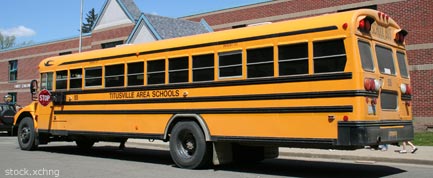No Idling Saves School Bus Kids

Some 24 million U.S. schoolchildren are exposed every weekday to the exhaust of the school buses they ride on—but according to a recent EPA study, there’s a simple way to reduce this exposure: don’t idle.
On average, children spend 1.5 hours parked on the seats of school buses each weekday, and previous studies have shown that they are exposed to more pollutants expelled by a bus’s diesel engine than people on the street outside.
Diesel engines emit fine particulate matter, which is found in smog and haze and can penetrate deep into the lungs. These tiny particles can aggravate chronic lung conditions like asthma and lead to problems in healthy people, but especially in children, whose lungs are still developing.
The burning of fuel also produces nitrous oxides, which also contribute to smog, and carbon monoxide.
While buses are lined up outside a school, waiting for young passengers, most drivers sit with the engines idling, to “keep the engine warm.”
It was previously though that more pollution would be emitted in the initial smoke puff after an engine was turned off and then restarted than if the engine were left idling, so Environmental Protection Agency scientists put that idea to the test.
They found that turning the engine off and restarting resulted in a 99 percent reduction in nitrous oxides and carbon monoxide and an 83 percent reduction in particulates compared to the emissions from a bus idling for 20 minutes.
Sign up for the Live Science daily newsletter now
Get the world’s most fascinating discoveries delivered straight to your inbox.
“Pollution from school buses has health implications for everyone, especially asthmatic children,” said EPA Regional Administrator Alan J. Steinberg, in a prepared statement. “This study really shows in no uncertain terms that allowing a bus to idle exposes children to more pollution and shows that a very simple step—shutting off the engine—can really make a difference.”
To make that difference in pollution levels, the EPA scientists say, if a bus expects to idle longer than 3 minutes, drivers should just turn the engine off and restart when it's ready to roll.
The same applies with gas-powered cars: if you expect to idle longer than 30 seconds, it saves gas and reduces pollution if you simply shut the engine off. So instead of going through the drive-through at the fast-food restaurant, park your car and go inside.
Quiz: What's Your Environmental Footprint?
Children on School Buses Breathe More Pollution
Top 10 Ways to Destroy Earth

Andrea Thompson is an associate editor at Scientific American, where she covers sustainability, energy and the environment. Prior to that, she was a senior writer covering climate science at Climate Central and a reporter and editor at Live Science, where she primarily covered Earth science and the environment. She holds a graduate degree in science health and environmental reporting from New York University, as well as a bachelor of science and and masters of science in atmospheric chemistry from the Georgia Institute of Technology.









